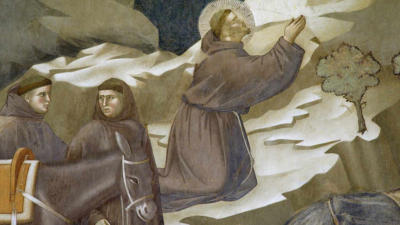Francis: A fork in the road
St. Francis of Assisi
When Francis returned from the Crusades/Holy Land, the Order had grown tremendously and expanded well beyond Assisi. Francis and the Order were at a fork in the road.

After his 1220 return from his mission/travels to Egypt, Palestine, Syria, and Asia Minor, Francis of Assisi resigned as “minister” of the Franciscan movement. As with most changes in the life of St. Francis, there are a host of modern commentaries that offer reasons why. Some conjectured Francis was upset that clerics, ordained priests, were starting to inject their priestly charism upon the fraternity; hence he resigned in protest. Others offer that he was protesting the increased oversight and intrusion of the Pope into the affairs of the friars and their life. Some have insisted that Francis recognized that this religious movement was becoming a religious order – something he did not intend nor desire.
I think that Andre Vauche has the most likely answer, one that does not overly rely on one biographical or hagiographic source: “In fact, the reality is both simpler and less dramatic. In asking the help of the papacy in 1220, the Poor Man of Assisi was not throwing himself into the mouth of the wolf with the cleverness of an innocent lamb; he was acknowledging that his personal action and energy were no longer sufficient to assure the direction of his fraternity, which was passing through a crisis of growth tied to its change of status. … From the moment when the dream of the founder is shared with others—however purely spiritual one might imagine it to be—a discipline is imposed and soon the rigor of law. To be established, the religious family needs a formal recognition by the hierarchy. To live, it has to have rules of admission, temporal resources, status of members, governance. The acceptance of the rule, under the governance of a leader: such is the principle of unity of every religious family.”
The penitential and evangelical nature of the Franciscan movement was not unique to its time. There were approximately 130 other “movements”, some heretical, most not, that were concurrent to Francis’ day. The Franciscan family is the only one that continues in existence today. While some might lament Vauche’s insight about the imposition of discipline, rigor, and recognition, one suspects that more would lament the absence of the Franciscan presence in our time.
There was nothing in Francis’ life that prepared him for leadership of an evangelical fraternity, which was already beginning to span the European continent. He had been a spoiled dilatant, a would-be knight, a wounded warrior, a solitary figure, living a quasi-hermetical life, and now he was the “leader” of a growing, international community of brothers seeking to follow his way of being Christian in the world. Virtually all scholars agree that Francis, in the beginning, did not envision his group to be more than a small group of men living an evangelical life in common. But there are also no indications that Francis thought too far ahead in any matter at this point in his life. Things just seemed to unfold, signs appeared along the way, and Francis followed the path in faith. And people followed Francis. Whether he liked it or not, Francis was their leader. The leader acceptable in 1209 was different from the one needed in 1220.
Vauche continues: “Francis did not feel that he was the person for this new situation. It is for this reason that he preferred to voluntarily let go of the direction of a movement, which had been, up to then, totally his. No founder or leader of an order in the Middle Ages had had such a power. But he did not, for all that, give up influencing the order or orienting its future. On the contrary, it is in leaving to his ‘vicar’ and to the Roman Church the care of making decisions of a normative or disciplinary type that he could hope to preserve a superior authority, of a spiritual type, that would only have been diminished in the heat of daily administration. Aware of the changes which had become inevitable, the Poor Man of Assisi was going henceforth to limit their extent by proposing himself as a model: certainly not to put himself forward but in order to provide the friars a living illustration of the way to be and live as a Friar Minor. To the hierarchy of authority he would henceforth juxtapose a hierarchy of example through his own personal witness.” Both were necessary.
In an earlier installment of this series (Integrating into the Church), we noted that Francis had encountered Cardinal Hugolino (the future Pope Gregory IX) several years prior. Hugolino served Francis and the brothers as an advisor and advocate at the papal curia. During Francis’ travels abroad, Hugolino had gently “bailed out” the friars as they wandered. Hugolino’s biographer later wrote: “he took in hand the order of Friars Minor, which at the beginning was wandering without any specific boundaries, by giving it a new rule, thereby conferring a form onto this formless movement.” Even if the author exaggerates the role of the future pope Gregory IX a bit, there is no doubt that the institutional genesis of the order was the result of a close collaboration between Francis, the provincial ministers, and the cardinal, at the end of which the papacy vouched for the order of Friars Minor by means of a more intensive introduction of the brothers into pastoral activities across the breadth of Christendom.
Francis was beginning a new period of his journey of faith. His brother friars were beginning a path that, while parallel to his, was different and began to reveal the charism of the Order apart from the individual charism of the founder. Even St. Clare and her religious sisters would begin to find their own path in the world, but always rooted in the vision and spirit of St. Francis.